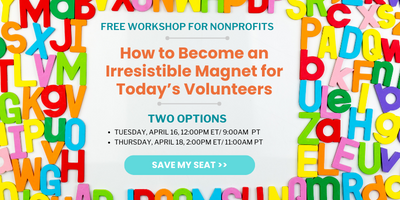 Pro Roundup for Volunteer Coordinators: How to Build Resilience in Challenging Times
Pro Roundup for Volunteer Coordinators: How to Build Resilience in Challenging Times
To say that 2020 has been a challenging year would be the understatement of the century. The past six months have been fraught with difficulties, challenges, and issues, ranging from anxiety due to the pandemic, stress due to juggling multiple priorities, concern about how to make ends meet with lost jobs, and anger due the injustice Black people continue to face in our society.
It’s enough to make even the strongest amongst us crumble under the pressure, and it doesn’t seem to be subsiding anytime soon. So, how do we adapt? We build resilience. But what does that mean exactly and how do we achieve resilience?
In this month’s roundup, I will define resilience and showcase five, science backed strategies that will help you build resilience.
What is Resilience?
Psychology Today defines resilience as:
“The psychological quality that allows some people to be knocked down by the adversities of life and come back at least as strong as before. Rather than letting difficulties, traumatic events, or failure overcome them and drain their resolve, highly resilient people find a way to change course, emotionally heal, and continue moving toward their goals.”
A similar concept to resilience is the term “bounced back”, which is reserved for when someone overcomes a hurdle while maintaining a positive outlook and continuing on with their life versus wallowing in despair.
Why You Need to Build Resilience
When we face challenges, it is easy to feel like there is no way out, like there is no way to swim against the current, so to speak.
However, the ability to build resilience and overcome the difficulties of life can serve you well in various aspects of life:
- It can improve your learning and contribute to your future achievement
- It can make you physically healthier
- It can increase engagement in your family and community
5 Strategies to Build Resilience
Now that you know what resilience is and how it can impact your life, it’s time to learn how you can cultivate and grow this important skill.
If you find yourself avoiding sadness, anger, or frustration out of convenience (you don’t want to bother your friends, family, colleagues, etc., or you don’t want to wallow), it may be time to learn healthy ways to work through these feelings.
One way is to build resilience that will help you cope better.
The Greater Good Science Center has curated a list of resilience practices on their website, Greater Good in Action, that can help you foster this skill.
If you are short on time, check out my suggested activities from each of their five strategies to build resilience:
1) Change your narrative
2) Face your fears
3) Practice self-compassion
4) Meditate
5) Cultivate forgiveness
Change Your Narrative
If you are like me, when I make a mistake or experience something bad, I tend to replay everything that led up to the event, over and over again. This means I am bringing up the sad, angry, frustrated, etc. emotions without ever resolving them.
Journaling is a great way you can start to work through any negative emotions you are experiencing.
First, journaling gets your emotions and feelings about life out into the open, versus keeping them stuffed deep inside, which is harmful to mental and physical health.
Second, journaling naturally encourages you to create a narrative that led up to a traumatic event or experience and give you some sense of control over your response.
If you don’t already have a journaling practice in place, try this expressive writing activity to get you started.
Beware before starting a journaling practice that you aren’t focusing on just the negative emotions you are facing. If you want to build resilience, journaling will help you, but only if your writing on an event eventually moves from emotions to thoughts. Those thoughts will help you make observations, notice patterns, and set goals for the future.
Face Your Fears
While journaling can help you overcome past trauma, it’s much harder to write about a situation you are currently in when the wounds are fresh.
That’s not to say you have to suffer in pain if you are currently facing a challenge, though.
The Overcoming a Fear practice can help you tackle emotions that are getting in the way of everyday life, such as the fear of public speaking, heights, or flying.
A quick disclaimer on this practice: only use this for mild, everyday fears. If you are facing fears related to a serious mental illness, work with a mental health professional to address them.
This practice will encourage you to tackle your fears head on with exposure therapy. If you slowly start exposing yourself to your fear, and experience only good outcomes, you will start to have more positive associations with the fear instead of negative associations, and you will be more likely to have the courage to confront it.
Practice Self-compassion 
To be self-compassionate is to stop judging and evaluating yourself, especially during times of stress.
Yes, it is important that you confront what is going on, but as you do, you need to treat yourself with the same kindness and care you would a friend facing the same obstacle.
As defined by Dr. Kristin Neff, there are three elements of self-compassion:
1) Self-kindness vs. Self-judgement: being open and understanding towards or failures or when we are suffering, versus self-criticizing or ignoring pain.
2) Common humanity vs. Isolation: recognize that suffering is part of the shared human experience, and is something that happens to everyone and not just you alone.
3) Mindfulness vs. Over-identification: observing your thoughts and feelings, without denying them or getting caught up by them.
So, how can you start practicing self-compassion to help you build resilience? Try these two activities:
Take a self-compassion break every time you start to feel overwhelmed, with the goal of completing one break at least once a week. This 5-minute activity will address all three elements of self-compassion and will make it easier for you to work through stress to reach calmness and happiness.
Ask yourself: How would you treat a friend? Your response is likely going to be with less judgement and more kindness and compassion than you respond to yourself. However, this exercise will get you thinking about how you can treat yourself in a challenging situation to mirror how you would treat a friend in the same situation.
Meditate
We recently hosted a masterclass for our VolunteerPro Premium Members, and while we were chatting and catching up with members as is customary before getting started, we realized a recurring theme: lots of people were feeling stressed and overwhelmed.
So, we brought the 40-day Mindfulness at Work Challenge to our community.
The challenge of practicing mindfulness has brought members more into the present, and provides them with techniques for dealing with negative situations and reactions as they occur, rather than ruminate on feelings of fear, anger, or despair.
If you are interested in becoming more mindful, but don’t feel like you have the time to dedicate to the 40-day challenges, try mindful breathing instead. At its most basic level, you can practice mindful breathing by simply focusing your attention on your breath as you inhale and exhale.
With repeated practice, mindful breathing can distance you from your thoughts and feelings, which will allow you to work through them without overwhelm. It will also help you stay present in the moment and avoid distractions about your past and/or future.
Cultivate Forgiveness
Holding on to a grudge can hold you back, and when you feel ready to forgive someone, you can positively impact your mental and physical health.
There are nine steps to forgiveness:
1) Know your feelings
2) Commit to yourself
3) Understand what forgiveness means
4) Get the right perspective
5) Practice stress management
6) Manage your expectations
7) Re-focus your energy
8) Appreciate what you have
9) Reframe your view of the past
Read more about each step here.
If you still find it difficult to forgive, or you want a “quick fix” (the above activity will take time to properly work through each step), try a practice that will allow you to let go of anger through compassion.
This practice takes just five minutes to complete, and you can repeat it anytime you find yourself focusing on resentment or vengeance.
Research suggests that when people view offenders with compassion and as possessing the potential to change, they experience increased positive emotions and build resilience.
Keep the Momentum Going
When life throws a challenge your way, refer back to these practices to help you cope.
With continued practice, you will naturally turn to these techniques when you need to overcome a tough challenge. In addition, just knowing that you have taken the time to build resilience will boost your confidence and how you respond to difficulties.
Have you tried any of the techniques above or have any you’d like to share? Let us know in the comments.






